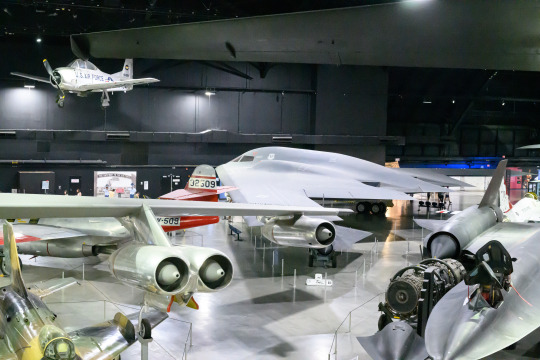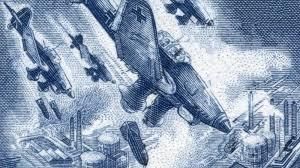#B-21 Raider
Explore tagged Tumblr posts
Text
General Thomas Bussiere, commander of the Air Force Global Strike Command, emphasized the strategic importance of the B-21 Raider, stating, “We are the free world’s only bomber force. Nobody on the earth is capable of what we are doing at this moment.”
Know more 👆🏻
0 notes
Text




I love the B-2 Spirit. Definitely one of my top 5 favorite airplanes. Once, when I was really little, my dad and I saw one fly overhead; unfortunately, I don't remember this, but I do remember seeing one at an air show in 2017 :D It's a stealth bomber, and when you see these things in action, you can see exactly what makes them stealth bombers. Their flat frame makes them difficult to see head-on, and even though they are just as loud as any other jet, you don't hear them until they are pretty darn close. The plane also incorporates technology that makes it "virtually invisible" to air defense radar systems.
Twenty-one of these aircraft were built; two have since crashed, leaving 19 in service. Northrop Gruman built two additional aircraft sans engines or instruments for testing, and the B-2 at the museum is one of these. The museum's B-2 also includes a front landing gear panel from the Spirit of Ohio decorated by technicians in honor of the extensive temperature testing that aircraft went through. You can sort of see it in the second picture; unfortunately, the picture I took of the panel itself came out blurry. You can also see it on the museum website here.
Each aircraft is named for a U.S. state, following the naming convention, "The Spirit of ____," except for two: "The Spirit of America" and "The Spirit of Kitty Hawk" (Kitty Hawk being the site of the first flight in 1903). The two aircraft that are no longer in service are the Spirit of Kansas and the Spirit of Hawaii; the Spirit of Georgia is currently undergoing repairs.
The US Air Force plans to continue to operate the B-2 until 2032, at which time they will be replaced by the B-21 Raider. In case anyone was worried, the B-21 looks like an aircraft that would belong to Batman, too.
#original post#National Museum of the United States Air Force#United States Air Force Museum#aviation history#airplanes#Cold War#B-2#B-2 Spirit#B-21 Raider#air shows
1 note
·
View note
Text
The Future of Air Defense: Adapting to Emerging Threats
Introduction:
In an era marked by rapid technological advancements and evolving geopolitical landscapes, the realm of air defense is undergoing a paradigm shift. From the historic battles of World War II to the dawn of unmanned bomber drones and the advent of stealth bombers like the B-21 Raider, the trajectory of air defense has been shaped by innovation and necessity. This article delves into the modernization of air defense systems, exploring how contemporary threats are driving the development of next-generation defenses.

Modern Air Defenses: Meeting the Challenges of the 21st Century
The complexities of modern warfare demand air defense systems that are versatile, agile, and highly effective. Today's adversaries possess an array of advanced aerial capabilities, including stealth aircraft, hypersonic missiles, and unmanned aerial vehicles (UAVs). As such, the need for robust air defense solutions has never been greater.
In response to these challenges, nations around the world are investing in cutting-edge technologies to enhance their air defense capabilities. Advanced radar systems with multi-function capabilities enable early detection of incoming threats across various spectrums, from low-flying drones to high-altitude bombers.
Moreover, the integration of artificial intelligence (AI) and machine learning algorithms is revolutionizing air defense operations. AI-driven systems can analyze vast amounts of sensor data in real-time, enabling more accurate threat assessment and decision-making.
The B-21 Raider: Redefining Stealth and Strategic Bomber Capabilities
Central to the future of air defense is the development and deployment of next-generation strategic bombers like the B-21 Raider. Designed to succeed the venerable B-2 Spirit, the B-21 embodies the latest advancements in stealth technology, electronic warfare capabilities, and long-range precision strike capabilities.
Stealth remains a cornerstone of the B-21's design, allowing it to penetrate enemy airspace undetected and deliver payloads with unprecedented accuracy. Additionally, the B-21 boasts enhanced survivability features, including advanced countermeasures and autonomous systems that can adapt to dynamic threat environments.
The B-21 Raider represents a formidable challenge for air defense planners, who must develop innovative strategies and technologies to detect and neutralize these stealthy adversaries. From advanced radar systems capable of detecting low-observable aircraft to networked sensor arrays that provide comprehensive situational awareness, countering the B-21 requires a holistic approach to air defense.
Unmanned Bomber Drones: A New Frontier in Aerial Warfare
The proliferation of unmanned aerial vehicles (UAVs), including unmanned bomber drones, has introduced new complexities to the air defense landscape. These agile and cost-effective platforms offer adversaries a potent means of conducting reconnaissance, surveillance, and precision strikes with minimal risk to human operators.
To address the threat posed by unmanned bomber drones, air defense systems must evolve to incorporate novel detection and interception capabilities. Advanced sensor fusion technologies, coupled with AI-driven algorithms, enable rapid identification and tracking of UAVs in diverse operational environments.
Moreover, the development of directed energy weapons (DEWs) and electromagnetic pulse (EMP) technologies holds promise for countering unmanned bomber drones. DEWs, such as high-energy lasers and microwave weapons, can disable or destroy UAVs with precision and efficiency, offering a non-kinetic means of neutralizing aerial threats.

The future of air defense hinges on innovation, adaptation, and collaboration across military, industry, and academic sectors. As adversaries continue to develop and deploy advanced aerial capabilities, the imperative to stay ahead of the threat curve has never been more critical.
By embracing emerging technologies, such as AI, stealth, and directed energy, nations can ensure their air defense systems remain effective and resilient in the face of evolving threats. From the skies of World War II to the dawn of unmanned bomber drones and beyond, the evolution of air defense reflects humanity's enduring quest for security and supremacy in the aerospace domain.
0 notes
Text
B-21 Raider Takes to the Sky: Headline Horizon News
The highly anticipated B-21 Raider stealth bomber successfully completes its first test flight, marking a quantum leap in military technology and redefining the future of air warfare.
0 notes
Text

The B-21 Raider conducting flight testing recently, the trailing air data sensor is visible as is the air intake which appears white [From USAF video] #B21 #aviation
@Saint1Mil via X
58 notes
·
View notes
Text

Another picture of the B-21 Raider in flight,November 2024
35 notes
·
View notes
Text

B-21 "Raider" lands at Edwards Air Force Base, California
35 notes
·
View notes
Text
Cloudcuckoolander Tally Part 6: Chapter 1-6, or, 'Can't I be Sir Not-Appearing-In-This-Film instead?
And we're back with part 6 of the Tally, Covering Merlin's infodump! A bit shorter than usual because there is less 'meat' to this topic, which is why I'm double posting it with part 7.
Chapter 1-6
After Merlin Introduces themselves -"…" I say eloquently. --This sounds like it's time for an interpretive dance! +1 Cuckoo --"The celery stalks at midnight. And ice cream saves lives," I cryptically say. This and nothing more. +1 Cuckoo
During your introductions
-I wonder if one could eat people's names, what would they taste like? +1 Cuckoo
If you pick to give Merlin a fake name, and then input either your real name or your real name but inverted (last name first and first name last):
-No, this is perfect! No one will ever suspect that my true name is actually the same as my fake name! It's pure unadulterated genius! +1 Cuckoo No, this is perfect! No one will ever suspect that my true name is actually the inversion of my fake name! It's pure unadulterated genius! +1 Cuckoo
Merlin's Infodump:
-What is all this about demons? Hellhounds? The nether realm? --How did the demons even manage to track us down in the first place? And if they've been doing that all along, does this make them the Midnight Mauler? ---Of course, I'm guaranteed to be very delicious. +1 Cuckoo
-First things first… what is this about a potential apocalypse? --"I always knew that I was a rose beginning to bloom! Now I just have to find the Grey and start handing out kisses…" +1 Cuckoo
-What does Camelot have to do with what's going on now? --Who exactly are all these other immortals out there? ---Who are the fae? ----"Not for thy fairy kingdom. Fairies, away! We shall chide downright, if I longer stay. I know a bank where the wild thyme blows. Where oxlips and the nodding violet grows, quite overcanopied with luscious woodbine, with sweet musk roses and with eglantine…" +1 Cuckoo
When showing your demonic mark to Merlin: -I immediately launch into a detailed recounting of my strange dream and the strange contusion that followed it. --But why did King Arthur maul me in my dreams? ---Maybe I should send Arthur an apology card for suspecting him? +1 Cuckoo
Calling dibs on Lamorak: -(If at least friendly with Adrian and your phone isn't the Juke) Of course, it's all connected! I whip out a mental pinboard within my mind. +1 Cuckoo
Calling Dibs on Mordred: -No, this plan is brilliant! We can't be betrayed by Mordred if I'm Mordred! +1 Cuckoo
During the reincarnation talks: -I wonder if a knight in flight can take down a B-21 Raider? +1 Cuckoo
What exactly are these Lesser and Greater Circles and what are we supposed to be doing about them? -I know I could've taken down the world by now if it wasn't for Madagascar! +1 Cuckoo
26 notes
·
View notes
Text

So I redesigned Cascade again! His altmode is now the new B-21 Raider stealth bomber and his anatomy is much more figured out than it was before. Congrats babygirl now you can actually move your arms to the sides!
74 notes
·
View notes
Text

Evolution of Northrop Flying Wing Bombers from the YB-35 to the B-21 Raider!
32 notes
·
View notes
Text
GUYS HEAR ME OUT
CYBERTRONIAN ANGELS
THERE ARE VERY FEW OF THEM AND THEY’RE UNGODLY POWERFUL AND FAST
THEY CAN COMPARE TO THE PRIMES-
B-21 Raiders are femmes
B-2s are mechs
Thoughts?
Am I cookin?
B-21 Raider (smaller but faster, better stealth than B-2 Spirit)

B-2 Spirit (bigger but less fast, although cooler lookin)

Here’s the size difference:

4 notes
·
View notes
Text
Evolution of Air Defenses: From World War II to Modern Times
Introduction:
The evolution of air defenses has been a constant endeavor driven by the advancement of technology and the changing nature of aerial threats. From the crude anti-aircraft guns of World War II to the cutting-edge modern systems like the B-21 Raider and unmanned bomber drones, the landscape of air defense has undergone remarkable transformations. This article explores this journey, tracing the development of air defense mechanisms through key historical milestones and contemporary advancements.

World War II: The Birth of Modern Air Defenses
World War II marked a significant turning point in the history of air defense. With the emergence of strategic bombing campaigns, nations realized the urgent need for effective defense mechanisms against aerial threats. During this era, anti-aircraft guns became the primary means of defense, employed both on the ground and aboard naval vessels.
The Battle of Britain stands out as a pivotal moment in the annals of air defense history. The British Royal Air Force (RAF) employed a combination of radar detection, fighter aircraft, and anti-aircraft artillery to repel the relentless Luftwaffe raids. Radar technology, in particular, played a crucial role, providing early warning of incoming enemy aircraft and enabling a coordinated response.
However, despite these advancements, the effectiveness of air defenses during World War II was limited. The sheer scale of aerial bombardment, coupled with the speed and altitude capabilities of aircraft, posed significant challenges for traditional anti-aircraft systems.
Post-World War II: Technological Innovations and Strategic Shifts
The end of World War II marked the beginning of a new era in air defense technology. The advent of jet-powered aircraft and the looming threat of nuclear warfare necessitated a radical rethink of defense strategies. In response, nations invested heavily in the development of more sophisticated air defense systems.
One of the most notable developments during this period was the introduction of surface-to-air missiles (SAMs). These long-range missiles offered a significant improvement over traditional anti-aircraft guns, providing greater reach and accuracy. The Soviet Union's deployment of the S-75 Dvina (NATO reporting name: SA-2 Guideline) surface-to-air missile system during the Cold War exemplified the growing importance of SAMs in air defense.
Meanwhile, advancements in radar technology continued to enhance early warning capabilities, enabling faster detection and response times. The integration of radar networks with command and control systems allowed for more coordinated and efficient air defense operations.
The Rise of Stealth and Strategic Bombers: Challenges and Responses
The emergence of stealth technology in the late 20th century presented new challenges for air defense systems. Stealth aircraft, such as the B-2 Spirit bomber, were designed to evade traditional radar detection, posing a significant threat to conventional air defenses.
In response, nations began developing countermeasures to mitigate the stealth capabilities of these aircraft. Advanced radar systems capable of detecting stealth aircraft at shorter ranges were deployed, while infrared and visual detection methods were also explored.
Furthermore, the development of next-generation strategic bombers, such as the B-21 Raider, underscored the ongoing arms race between offense and defense in the realm of air warfare. The B-21 Raider, slated to replace the aging B-52 and B-1 bombers, is designed to incorporate stealth technology and advanced avionics, further complicating the task of air defense planners.
Unmanned Bomber Drones: A Paradigm Shift in Air Warfare
In recent years, the proliferation of unmanned aerial vehicles (UAVs) has transformed the nature of aerial warfare. Unmanned bomber drones, in particular, have emerged as potent weapons platforms, offering greater flexibility and operational capabilities than their manned counterparts.
The advent of unmanned bomber drones presents both opportunities and challenges for air defense systems. On one hand, the smaller size and agility of UAVs make them difficult to detect and intercept using traditional means. On the other hand, their reliance on communication links and remote control systems makes them vulnerable to electronic warfare and cyber attacks.
To counter the threat posed by unmanned bomber drones, air defense systems have begun incorporating advanced sensor technologies and AI-driven algorithms. Autonomous drone detection and interception systems are being developed to provide a rapid response to emerging threats in real-time.
The evolution of air defenses from World War II to the modern era reflects the relentless pursuit of technological innovation and strategic adaptation. From the rudimentary anti-aircraft guns of the past to the sophisticated radar networks and stealth detection systems of today, air defense capabilities have evolved in response to changing threats and operational requirements.

As the pace of technological advancement accelerates and the nature of aerial warfare continues to evolve, the challenge for air defense planners lies in staying ahead of the curve. By embracing emerging technologies such as AI, unmanned systems, and advanced sensor networks, nations can ensure their air defense capabilities remain effective and resilient in the face of evolving threats.
0 notes
Text
This article laying out the need for a colossal expenditure to shore up our deep-strike capability -- they only ever built like 20 B-2s, and the average age of the rest of the US bomber fleet is, no joke, between 40 and 60 years old -- is so funny because the argument it seems to be making is look, all of our other shit is completely fucked and broken:
The bomber was previously intended to be supported by unmanned ‘wingman’ aircraft, although work on their development was cancelled in July 2022. Serious deficiencies in submarine construction, and major cost overruns and development issues that leave the future of the Sentinel intercontinental range ballistic missile program uncertain, have led to greater importance being attributed to the B-21 program as a means of striking targets deep inside enemy territory. Critics of plans to increase procurement have, among other factors, highlighted the rapid improvements to Chinese radar technologies which create a significant possibility of Chinese forces being able to detect and neutralise B-21s at very long ranges either by the time the bomber enters service or not long afterwards.
So like, this might not even work either, but man we definitely need 200 of them! Never mind that hypersonic missiles make all this shit obsolete anyway, we don't have those either. And these are the guys who all want to go to war with China and Russia! Oy vey
5 notes
·
View notes
